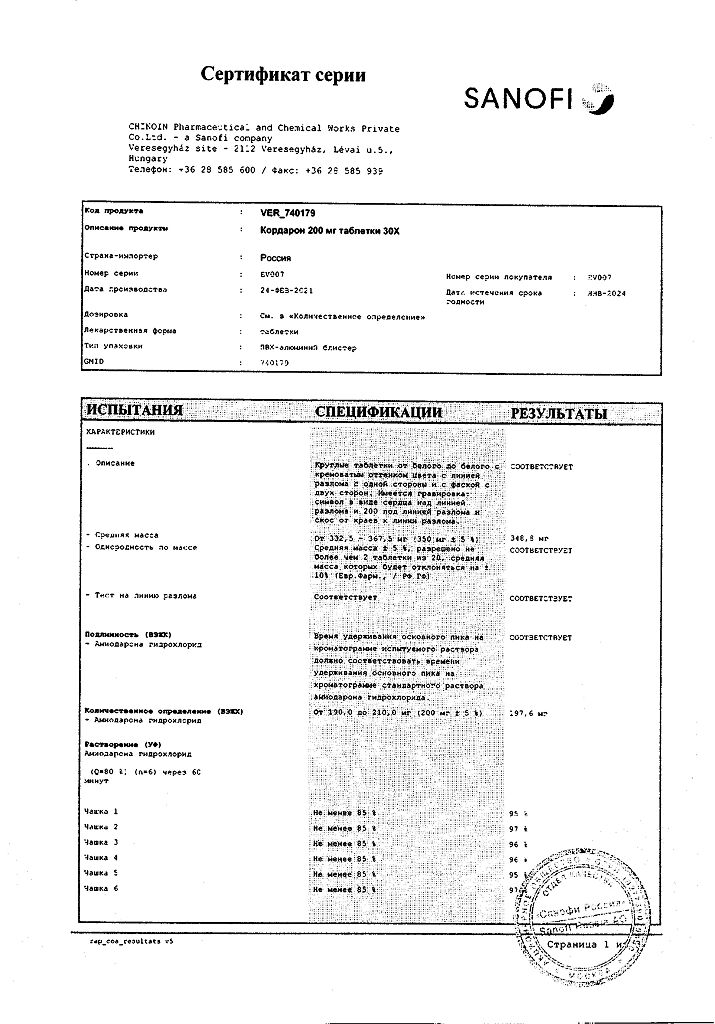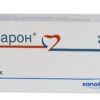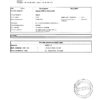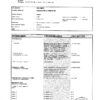No products in the cart.
Cordarone, tablets 200 mg 30 pcs
€6.51 €5.79
Description
Cordarone is an antiarrhythmic drug.
Amiodarone belongs to class III antiarrhythmic drugs (class of repolarization inhibitors) and has a unique mechanism of antiarrhythmic action because in addition to properties of class III antiarrhythmic agents (potassium channel blockade) it has effects of class I antiarrhythmic agents (sodium channel blockade), class IV antiarrhythmic agents (calcium channel blockade) and noncompetitive beta blocking action.
In addition to antiarrhythmic action, it has antianginal, coronary dilator, alpha- and beta-adrenoblocking effects.
Antiarrhythmic properties:
– increase the duration of the 3rd phase of the action potential of cardiomyocytes, mainly due to the blocking of the ionic current in potassium channels (effect of antiarrhythmic agent of class III according to Williams classification);
– reduction of sinus node automatism, resulting in decreased heart rate;
– non-competitive blockade of alpha- and beta-adrenergic receptors;
– Slowing-down of sinoatrial, atrial and atrioventricular conduction, more pronounced in tachycardia;
– Absence of changes in ventricular conduction;
– increased refractory periods and decreased excitability of atrial and ventricular myocardium, as well as increased refractory period of atrioventricular node;
– delayed conduction and increased duration of refractory period in additional bundles of atrial-ventricular conduction.
Other effects:
– decreased myocardial oxygen consumption by moderately reducing total peripheral resistance and heart rate, and decreasing myocardial contractility through beta-adrenoblocking action;
– Increase of coronary blood flow due to direct effect on coronary artery tone;
– Preservation of cardiac output, despite some decrease of myocardial contractility, due to the decrease of total peripheral resistance and aortic pressure;
– Effect on thyroid hormone metabolism: Inhibition of the conversion of T3 to T4 (blockade of thyroxine-5-deiodinase) and blocking the capture of these hormones by cardiocytes and hepatocytes, leading to a weakening of the stimulating effect of thyroid hormones on the myocardium.
– restoration of cardiac activity in cardiac arrest caused by ventricular fibrillation resistant to cardioversion.
Indications
Indications
Angina pectoris, paroxysmal rhythm disturbances: supraventricular tachycardia, atrial fibrillation, sinus tachycardia, extrasystole (supraventricular and ventricular).
Pharmacological effect
Pharmacological effect
Cordarone is an antiarrhythmic drug.
Amiodarone belongs to class III antiarrhythmic drugs (class of repolarization inhibitors) and has a unique mechanism of antiarrhythmic action, since in addition to the properties of class III antiarrhythmics (potassium channel blockade), it has the effects of class I antiarrhythmics (sodium channel blockade), class IV antiarrhythmics (calcium channel blockade) and a non-competitive beta-blocking effect.
In addition to the antiarrhythmic effect, it has antianginal, coronary dilation, alpha and beta adrenergic blocking effects.
Antiarrhythmic properties:
− increase in the duration of the 3rd phase of the action potential of cardiomyocytes, mainly due to blocking the ion current in potassium channels (the effect of a class III antiarrhythmic drug according to the Williams classification);
− decrease in the automaticity of the sinus node, leading to a decrease in heart rate;
− non-competitive blockade of alpha and beta adrenergic receptors;
− slowing of sinoatrial, atrial and atrioventricular conduction, more pronounced with tachycardia;
− no changes in ventricular conductivity;
− increase in refractory periods and decrease in excitability of the myocardium of the atria and ventricles, as well as an increase in the refractory period of the atrioventricular node;
− slowing down conduction and increasing the duration of the refractory period in additional atrioventricular conduction bundles.
Other effects:
− reduction of oxygen consumption by the myocardium due to a moderate decrease in total peripheral resistance and heart rate, as well as a decrease in myocardial contractility due to the beta-adrenergic blocking effect;
– increase in coronary blood flow due to a direct effect on the tone of the coronary arteries;
– preservation of cardiac output, despite a slight decrease in myocardial contractility, due to a decrease in total peripheral resistance and pressure in the aorta;
– influence on the exchange of thyroid hormones: inhibition of the conversion of T3 to T4 (blockade of thyroxine-5-deiodinase) and blocking the uptake of these hormones by cardiocytes and hepatocytes, leading to a weakening of the stimulating effect of thyroid hormones on the myocardium.
− restoration of cardiac activity in cardiac arrest caused by ventricular fibrillation, resistant to cardioversion.
Special instructions
Special instructions
Since the side effects of amiodarone are dose-related, patients should be treated with the lowest effective doses to minimize their occurrence.
Patients should be warned to avoid exposure to direct sunlight or to take protective measures (eg, use of sunscreen, wearing appropriate clothing) during treatment.
Treatment monitoring
Before starting amiodarone, it is recommended to conduct an ECG study and determine the level of potassium in the blood. Hypokalemia should be corrected before starting amiodarone. During treatment, it is necessary to regularly monitor the ECG (every 3 months) and the level of transaminases and other indicators of liver function.
In addition, due to the fact that amiodarone can cause hypothyroidism or hyperthyroidism, especially in patients with a history of thyroid disease, before taking amiodarone, a clinical and laboratory (TSH) examination should be performed to identify dysfunctions and diseases of the thyroid gland. During treatment with amiodarone and for several months after its cessation, the patient should be regularly monitored for clinical or laboratory signs of changes in thyroid function. If there is a suspicion of dysfunction of the thyroid gland, it is necessary to determine the level of TSH in the blood serum.
Regardless of the presence or absence of pulmonary symptoms during treatment with amiodarone, it is recommended to conduct an X-ray examination of the lungs and pulmonary function tests every 6 months.
In patients receiving long-term treatment for arrhythmias, cases of increased frequency of ventricular fibrillation and/or increased threshold for the response of a pacemaker or implanted defibrillator have been reported, which may reduce their effectiveness. Therefore, before starting or during treatment with amiodarone, these devices should be regularly checked for proper function.
The appearance of shortness of breath or a dry cough, either isolated or accompanied by a deterioration in general condition, should indicate the possibility of pulmonary toxicity, such as interstitial pneumopathy, the suspicion of which requires X-ray examination of the lungs and pulmonary function tests.
Due to the prolongation of the period of repolarization of the ventricles of the heart, the pharmacological action of Cordarone causes certain ECG changes: prolongation of the QT interval, QTc (corrected), possible appearance of U waves. It is permissible to increase the Q-Tc interval by no more than 450 ms or by no more than 25% of the original value. These changes are not a manifestation of the toxic effect of the drug, but require monitoring to adjust the dose and assess the possible proarrhythmogenic effect of Cordarone.
If II and III degree atrioventricular block, sinoatrial block or double-bundle intraventricular block develops, treatment should be discontinued. If first degree atrioventricular block occurs, monitoring should be intensified.
Although the occurrence of arrhythmia or worsening of existing rhythm disturbances has been noted, the proarrhythmogenic effect of amiodarone is weak, less than that of most antiarrhythmic drugs, and usually occurs in combination with certain drugs or in cases of electrolyte imbalance.
If vision is blurred or visual acuity is reduced, an ophthalmological examination, including fundus examination, should be performed. If neuropathy or optic neuritis caused by amiodarone develops, the drug must be discontinued due to the risk of blindness.
Since Cordarone contains iodine, its intake may distort the results of a radioisotope study of the thyroid gland, but does not affect the reliability of the determination of the content of T3, T4 and TSH in the blood plasma.
Before surgery, the anesthesiologist should be informed that the patient is receiving Cordarone.
Prolonged treatment with Cordarone may increase the hemodynamic risk inherent in local or general anesthesia. This particularly applies to its bradycardic and hypotensive effects, decreased cardiac output and conduction disturbances.
In addition, acute respiratory distress syndrome was observed in patients receiving Cordarone in rare cases immediately after surgery. During artificial ventilation of the lungs, such patients require careful monitoring.
Impact on the ability to drive a car and other mechanisms
During treatment with Cordarone, you should refrain from driving a car and engaging in potentially hazardous activities that require increased concentration and speed of psychomotor reactions.
Active ingredient
Active ingredient
Amiodarone
Composition
Composition
1 tablet contains amiodarone 200 mg.
Contraindications
Contraindications
Hypersensitivity, sinus bradycardia, AV block, thyroid disease, pregnancy.
Side Effects
Side Effects
Nausea, vomiting, constipation, bradycardia, euphoria, tremor, hypo- and hyperthyroidism, phlebitis, neuropathy, photosensitivity, headache, fatigue, allergic reactions.
Interaction
Interaction
– With drugs that can cause torsades de pointes (when combined with amiodarone, the risk of developing potentially fatal torsades de pointes increases):
− antiarrhythmic drugs: class IA (quinidine, hydroquinidine, disopyramide, procainamide), class III (dofetilide, ibutilide, bretylium tosylate), sotalol;
− other (non-antiarrhythmic) drugs such as bepridil; vincamine; some neuroleptics: phenothiazines (chlorpromazine, cyamemazine, levomepromazine, thioridazine, trifluoperazine, fluphenazine), benzamides (amisulpride, sultopride, sulpride, tiapride, veralipride), butyrophenones (droperidol, haloperidol), sertindole, pimozide; tricyclic antidepressants; cisapride; macrolide antibiotics (erythromycin for intravenous administration, spiramycin); azoles; antimalarials (quinine, chloroquine, mefloquine, halofantrine, lumefantrine); pentamidine for parenteral administration; difemanil methyl sulfate; mizolastine; astemizole; terfenadine; fluoroquinolones (in particular moxifloxacin).
Not recommended combinations
– With beta-blockers, with blockers of “slow” calcium channels that slow down the heart rate (verapamil, diltiazem), since there is a risk of developing disorders of automaticity (severe bradycardia) and conduction.
– With laxatives that stimulate intestinal motility, which can cause hypokalemia, which increases the risk of developing torsade de pointes (TdP). When combined with amiodarone, laxatives from other groups should be used.
Combinations requiring caution when using
– With drugs that can cause hypokalemia:
– diuretics that cause hypokalemia (in monotherapy or combination);
– amphotericin B (iv);
– systemic glucocorticosteroids;
– tetracosactide.
Increased risk of developing ventricular arrhythmias, especially ventricular tachycardia of the “pirouette” type (hypokalemia is a predisposing factor). It is necessary to monitor the level of electrolytes in the blood, if necessary, correct hypokalemia and constant clinical and electrocardiographic monitoring of the patient. In case of development of ventricular tachycardia of the “pirouette” type, antiarrhythmic drugs should not be used (ventricular pacemaker should be started, intravenous administration of magnesium salts is possible).
– With procainamide (see “Interaction. Contraindicated combinations”
Amiodarone may increase plasma concentrations of procainamide and its metabolite N-acetylprocainamide, which may increase the risk of procainamide side effects.
– With indirect anticoagulants
Amiodarone increases warfarin concentrations by inhibiting cytochrome P450 2C9. When warfarin is combined with amiodarone, the effects of the indirect anticoagulant may be enhanced, which increases the risk of bleeding. Prothrombin time (INR) should be monitored more frequently and anticoagulant doses adjusted both during treatment with amiodarone and after its discontinuation.
– With cardiac glycosides (digitalis preparations)
Possibility of disturbances in automaticity (severe bradycardia) and atrioventricular conduction. In addition, when combining digoxin with amiodarone, an increase in the concentration of digoxin in the blood plasma is possible (due to a decrease in its clearance). Therefore, when combining digoxin with amiodarone, it is necessary to determine the concentration of digoxin in the blood and monitor possible clinical and electrocardiographic manifestations of digitalis intoxication. Digoxin dosages may need to be reduced.
– With esmolol
Violations of contractility, automaticity and conductivity (suppression of compensatory reactions of the sympathetic nervous system). Clinical and ECG monitoring is required.
– With phenytoin (and, by extrapolation, with fosphenytoin)
Amiodarone can increase plasma concentrations of phenytoin due to inhibition of cytochrome P450 2C9, therefore, when combining phenytoin with amiodarone, an overdose of phenytoin may develop, which can lead to the appearance of neurological symptoms; clinical monitoring is necessary and, at the first signs of overdose, a reduction in the dose of phenytoin; it is advisable to determine the concentration of phenytoin in the blood plasma.
– With flecainide
Amiodarone increases plasma concentrations of flecainide due to inhibition of cytochrome CYP 2D6. Therefore, dose adjustment of flecainide is required.
– With drugs metabolized by cytochrome P450 3A4
When amiodarone, a CYP3A4 inhibitor, is combined with these drugs, their plasma concentrations may increase, which may lead to increased toxicity and/or increased pharmacodynamic effects and may require dose reductions. Such drugs are listed below.
– Cyclosporine
There may be an increase in the level of cyclosporine in the blood plasma, associated with a decrease in the metabolism of the drug in the liver, which may increase the nephrotoxic effect of cyclosporine. It is necessary to determine the concentration of cyclosporine in the blood, monitor kidney function and correct the dosage regimen of cyclosporine during treatment with amiodarone and after discontinuation of the drug.
– Fentanyl
Combination with amiodarone may increase the pharmacodynamic effects of fentanyl and increase the risk of developing its toxic effects.
– Other drugs metabolized by CYP 3A4: lidocaine (risk of sinus bradycardia and neurological symptoms), tacrolimus (risk of nephrotoxicity), sildenafil (risk of increased side effects), midazolam (risk of psychomotor effects), triazolam, dihydroergotamine, ergotamine, simvastatin and other statins metabolized by CYP 3A4 (increased risk of muscle toxicity, rhabdomyolysis, and therefore the dose of simvastatin should not exceed 20 mg per day; if it is ineffective, you should switch to another statin that is not metabolized by CYP 3A4).
– With orlistat
Risk of decreased plasma concentrations of amiodarone and its active metabolite. Clinical and, if necessary, ECG monitoring is necessary.
– With clonidine, guanfacine, cholinesterase inhibitors (donepezil, galantamine, rivastigmine, tacrine, ambenonium chloride, pyridostigmine bromide, neostigmine bromide), pilocarpine
Risk of developing excessive bradycardia (cumulative effects).
– With cimetidine, grapefruit juice
Slowing down the metabolism of amiodarone and increasing its plasma concentrations may increase the pharmacodynamic and side effects of amiodarone.
– With drugs for inhalation anesthesia
The possibility of developing the following severe complications in patients receiving amiodarone while receiving general anesthesia has been reported: bradycardia (resistant to atropine), arterial hypotension, conduction disturbances, decreased cardiac output.
There have been very rare cases of severe complications from the respiratory system (acute respiratory distress syndrome in adults), sometimes fatal, that developed immediately after surgery, the occurrence of which is associated with high oxygen concentrations.
– With radioactive iodine
Amiodarone contains iodine and therefore can interfere with the absorption of radioactive iodine, which can distort the results of radioisotope studies of the thyroid gland.
– With rifampicin
Rifampicin is a strong CYP3A4 inducer and, when co-administered with amiodarone, can reduce plasma concentrations of amiodarone and desethylamiodarone.
– With St. John’s wort preparations
St. John’s wort is a potent inducer of CYP3A4. In this regard, it is theoretically possible to reduce the plasma concentration of amiodarone and reduce its effect (clinical data are not available).
– With HIV protease inhibitors (including indinavir)
HIV protease inhibitors are CYP3A4 inhibitors. When used simultaneously with amiodarone, the concentration of amiodarone in the blood may increase.
– With clopidogrel,
Clopidogrel, which is an inactive thienopyrimidine drug, is metabolized in the liver to form active metabolites. There is a possible interaction between clopidogrel and amiodarone, which may lead to a decrease in the effectiveness of clopidogrel.
– With dextromethorphan
Dextromethorphan is a CYP2D6 and CYP3A4 substrate. Amiodarone inhibits CYP2D6 and may theoretically increase plasma concentrations of dectromethorphan.
Overdose
Overdose
With oral administration of very large doses, several cases of sinus bradycardia, cardiac arrest, attacks of ventricular tachycardia, paroxysmal tachycardia of the “pirouette” type and liver damage have been described. Atrioventricular conduction may slow down and pre-existing heart failure may worsen.
Treatment should be symptomatic (gastric lavage, administration of activated charcoal (if the drug has been taken recently), in other cases symptomatic therapy is carried out: for bradycardia – beta-adrenergic stimulants or installation of a pacemaker, for pirouette-type tachycardia – intravenous administration of magnesium salts or cardiac stimulation. Neither amiodarone nor its metabolites are removed by hemodialysis.
There is no specific antidote.
Storage conditions
Storage conditions
In a place protected from light, at a temperature not exceeding 15 °C.
Manufacturer
Manufacturer
Hinoine Pharmaceutical and Chemical Plant, Hungary
Additional information
| Conditions of storage | In a place protected from light, at a temperature not exceeding 15 °C. |
|---|---|
| Manufacturer | Sanofi Winthrop Industry, France |
| Medication form | pills |
| Brand | Sanofi Winthrop Industry |
Related products
Buy Cordarone, tablets 200 mg 30 pcs with delivery to USA, UK, Europe and over 120 other countries.





















